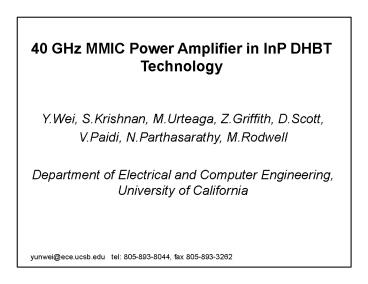40 GHz MMIC Power Amplifier in InP DHBT Technology - PowerPoint PPT Presentation
Title:
40 GHz MMIC Power Amplifier in InP DHBT Technology
Description:
f0=90 GHz. BW3dB=20 GHz. GT=8.2 dB. P1dB=9.5 dBm. Psat=12.5 dBm, associated gain: 4 dB ... designs for 100 mW saturated output power now being tested ... – PowerPoint PPT presentation
Number of Views:380
Avg rating:3.0/5.0
Title: 40 GHz MMIC Power Amplifier in InP DHBT Technology
1
40 GHz MMIC Power Amplifier in InP DHBT Technology
- Y.Wei, S.Krishnan, M.Urteaga, Z.Griffith,
D.Scott, - V.Paidi, N.Parthasarathy, M.Rodwell
- Department of Electrical and Computer
Engineering, University of California
yunwei_at_ece.ucsb.edu tel 805-893-8044, fax
805-893-3262
2
Outline
LEC 2002
UCSB
- Introduction
- Transferred-Substrate Power DHBT Technology
- Circuit Design
- Results
- Conclusion
3
Introduction
LEC 2002
- Applications for power amplifiers in Ka band
- satellite communication systems
- wireless LANs
- local multipoint distribution system
- personal communications network links and digital
radio - MMIC Amplifiers in this frequency band
- Kwon et. al., IEEE MTT, Vol.48, No. 6, June.
2000 - 3 stage HEMT, class AB, Pout1 W, Gain15
dB, PAE28.5, size9.5 mm2 - This Work
- Single stage cascode InP DHBT, class A,
Pout50 mW, Gain7 dB, PAE12.5 size0.42 mm2
4
Transferred-Substrate HBT MMIC fabrication
5
MBE DHBT layer structure
Band profile at Vbe0.7 V, Vce1.5 V
InP 8E17 Si 300 Å
400 Å InGaAs base 3000 Å InP collector
6
Small-area T.S. DHBTs have high cutoff
frequencies.
UCSB
Sangmin Lee
fmax 462 GHz, ft 139 GHz
BVCEO 8 V at JE 0.4 mA/?m2
Vce(sat) 1 V at 1.8 mA/?m2
7
Design difficulties with large-area power DHBTs
UCSB
ARO MURI
Yun Wei
Current hogging in multi-finger DHBT
Ic
Temperature
Thermal instability further increasescurrent
non-uniformity
Steady state current and temperature
distribution when thermally stable
Initial current and temperature distribution
thermal feedback further increases current
non-uniformity
Klt1 for thermal stability? must add emitter
ballast resistance
Distributed base feed resistance
base feed sheet resistance ?s 0.3
?/ significant for gt 8 um emitter finger length
Large Area HBTs big Ccb, small Rbb,
even small excess Rbb
substantially reduces fmax
Emitter contact
Metal1
0.08 ?m
Base contact
8
UCSB
First Attempt at Multi-finger DHBTs Poor
Performance Due to Thermal Instability
ARO MURI
Yun Wei
thermally driven current instability b
collapse
Jc5e4 A/cm2 Vce1.5 V
8 finger common emitter DHBT Emitter size 16 um
x 1 um Ballast resistor (design)9 Ohm/finger
low fmax due to premature Kirk effect
(current hogging) excess base feed resistance
9
Large Current High Breakdown Voltage Broadband
InP DHBT
UCSB
ARO MURI
Yun Wei
2nd-level base feed metal
8 -finger DHBT8 x (1 mm x 16 mm emitter )8 x
(2 mm x 20 mm collector ) Key Improvements8 Ohm
ballast per emitter finger2nd-level base feed
metal Device Performancefmaxgt330 GHz, Vbrceogt7
V,Jmaxgt1x105 A/cm2100 mA, 3.6 Volt device
emitter
Flip chip
collector
Ballast resistor
10
UCSB
ARO MURI
HBT power amplifier-why cascode?
Yun Wei
Advantages common-base stage has large Vce
? large output power common-emitter-stage has
low Vce ? small Rballast required ?
maintains large available power gain
Disadvantage inductance of base bypass
capacitor even small L greatly degrades gain
IE2
Vce2
-
IB1
IE1
Vce1
-
Rballast
radial stub capacitor
R. Ramachandran and A.F. Podell "Segmented
cascode HBT for microwave-frequency power
amplifiers"
11
UCSB
ARO MURI
InP TS DHBT Power Amplifier Design
Yun Wei
?/4
Optimum admittance match
?/4
Input match
Low frequency stabilization
Inter-stage DC bias
8 finger cascode
12
40 GHz 128 mm2 power amplifier
UCSB
ARO MURI
Yun Wei
cascode PA
f040 GHz BW3dB16 GHz GT7 dB P1dB14 dBm
Psat17 dBm _at_ 4dB gain
0.6mm x 0.7 mm, AE128 mm2
13
UCSB
ARO MURI
W band power amplifiers in TS InP DHBT technology
Yun Wei
common base PA
Bias Ic78 mA, Vce3.6 V f085 GHz BW3dB28
GHz GT8.5 dB P1dB14.5 dBm Psat16dBm,
associated gain 4.5 dB
0.5mm x 0.4 mm, AE128 mm2
Y. Wei et al, 2002 IEEE MTT-S symposium
14
W band power amplifiers in TS InP DHBT technology
UCSB
ARO MURI
Yun Wei
cascode PA
Bias Ic40 mA, Vce3.5 V f090 GHz BW3dB20
GHz GT8.2 dB P1dB9.5 dBm Psat12.5 dBm,
associated gain 4 dB
0.5mm x 0.4 mm, AE64 mm2
Y. Wei et al, 2002 IEEE MTT-S symposium
15
Continuing work
UCSB
LEC 2002
Yun Wei
Higher-current DHBTs for increased mm-wave output
power 250 GHz fmax, Ic,max240 mA, thermally
stable at 200 mA bias at Vce3.2 Volts ?
suitable for W-band 150 mW power
amplifiers W-band DHBT power amplifiers designs
for gt 100 mW saturated output power now being
tested Results to be reported subsequently
16
Conclusions
UCSB
LEC 2002
Yun Wei
- 40 GHz MMIC power amplifier in InP DHBT
technology - 7 dB power gain and 14 dBm output power at 1 dB
compression. 17 dBm (50 mW) saturated output
power 12.5 peak power added efficiency - Future work higher power DHBT power amplifiers
at W-band and above - lumped 4-finger topology, longer emitter fingers,
power combining - G-band (140-220 GHz) DHBT power amplifiers
- Acknowledgement
- Work funded by ARO-MURI program under contract
number PC249806.































